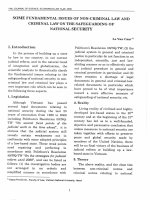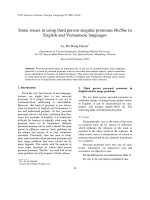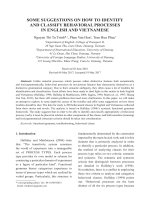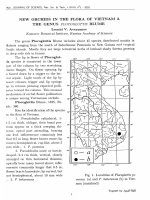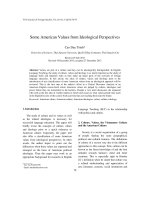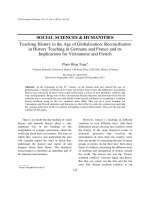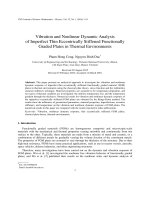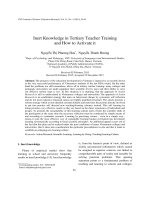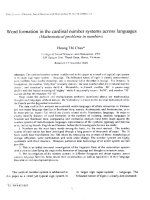DSpace at VNU: Some shortcomings in part 7 of the 2005 civil code of Vietnam
Bạn đang xem bản rút gọn của tài liệu. Xem và tải ngay bản đầy đủ của tài liệu tại đây (2.36 MB, 5 trang )
VNU.JOURNAL OF SCIENCE, ECONOMICS-LAW, Np2E, 2006
SOME SHORTCOMINGS IN PART 7 OF THE 2005 CIVIL CODE
OF VIETNAM
Ngo Huy C uong(,)
When the problem of amending the
1995 Civil Code was posed, it was
everyone's
hope
th a t
the
big
shortcomings of this Code, which were
found during the drafting process would
be corrected, including the stipulations
of civil relation with foreign factors.
Nevertheless, such hope had not only
been dashed but there also arose some
worries when the 2005 Civil Code was
passed. Due to my big disappointm ent, I
will not have a word for the
complimentation of the new Code. All
th a t I am going to deal with in this
article is upon the shortcomings of this
Code.
physical person and juristic person,
different
from
the
common
understanding th a t a person means a
natural person. Anyway, this definition
is right when it mentions both physical
person and juristic person as the subject
of civil code as in international
understanding. However, this good point
of the 1995 Civil Code was made wrong
in the 2005 Civil Code which writes as
follows: "Civil relation with foreign
factors is civil relation with a t least one
p art to be a foreign organization or
individual, or a Vietnamese person
living in a foreign country or civil
relation
between
Vietnamese
organizations or individuals/ 1* but the
1.
B a ck w a rd n ess
in
th e
ground for establishing, changing and
c o n c e p tu a lisa tio n
o f civ il
ending th a r relation is exercised
rela tio n w ith fo r eig n factors
according to a foreign law, generated in
1.1.
According to Article 826, Civil
a foreign country or with the property in
Code of 1995, "In this Code, civil relation
a foreign country” (Article 758).
with foreign factors means civil relation
This definition shows th a t the law
in which a foreigner or a foreign juristic
makers are not updated with the concept
person takes part, or civil relation which
of legal person, which is now divided into
is established, changed or ended in a
common and private legal persons (in
foreign country, or the property of which
countries with civil law). Nowadays,
is from a foreign country." This
legal person not only includes a hum an
definition fails to make a distinction
community or organization but also, say,
between
a foreigner and a foreign
a sole-trader. In my opinion, the law
juristic person. Instead, the concept of
regulation of relations with international
"person” in legal definition includes
n Dr., Faculty of Law, Vietnam National University, Hanoi
(1) Underline is mine.
16
Some shortcomings in Part 7 o f the 2005 Civil code o f Vietnam
factors requires
standard.
an
17
international-like
most of these conventions, international
air transportion is understood as any
1.2.
Clause 1, Article 827, Civil Code kind of transport by aeroplane of which,
according to the agreem ent between
of 1995 stipulated: "All legal stipulations
differrent parts in the transportation
of the Socialist Republic of Vietnam are
contract, destination and departure are
applied to civil relation with foreign
in two different countries' territories, or
factors, unless this Code launches
in the same country with an agreed
another stipulation”. This statem ent was
tran sit place in another country, without
exactly replicated in Clause 1, Article
any interruption in the transportation or
759, Civil Code of 2005. This statem ent
forwarding. This definition reveals no
force readers to understand th a t the
concept of subjects as foreign physical or
legal application to civil relation with
legal persons or related property. In
foreign factors is, first and foremost, a
sum, the definition of civil relation with
m atter of the Civil Code, and if the Civil
foreign factors in the 2005 Civil Code
Code has such a stipulation, then other
cannot be applied to international air
stipulations of other services will have
transportation.
be taken into account. It can be inferred
Although stipulations in the Civil
from this th a t the concept of "civil
Code in civil relation with foreign factors
relation with foreign factors" as
are gien priority, when confronting with
stipulated in the Clause above and other
specific issues, the 1995 Civil Code or in
issues concerned w ith civil relation with
the 2005 Civil Code will have to give the
foreign factors in P a rt 7 of the 2005 Civil
priority to other specific codes such as
Code covers all the civil relations with
the Aviation and Navigation laws. An
foreign
factors
generated
from
example for this can be taken from
international exchange. N aturally, the
Articles 766 and 773 in the 2005 Civil
law-makers have also imposed their
Code. This is a serious error law-makers
stipulations on the conflicts of laws in
committed due to their lack of
specific areas such as aviation and
knowledge aviation and navigation laws.
navigation. W hat m atters is th a t those
The conflicts in aviation will be
stipulations have led to big mistakes
discussed later.
th a t will be mentioned below.
International air transportion is an
interesting but complicated issue th at
attracts all nations' attention. In order
to unify different or even conflicting
principles and procedures, a great
number of Conventions have been signed
on the regulation of international air
transportion operation. According to
V N U , Journal o f Science, Econom ics-Law, N ^ E , 2006
2. The la ck o f p rin cip les
It is inevitable to refer to foreign
laws when regulating civil relations with
foreign factors. Nevertheless, the 2005
Civil Code lacks the principles for
application when it comes to refer to the
law of a multi-legal-system nation. A
multi-legal-system nation consists of two
18
kinds: (i) a nation w ith different
territories of different legal systems; and
(ii) a nation with different legal systems
applied to different classes of people.
With the first type of nation, each
territory is regarded as a separate
country. With the second type, legal
reference is taken to the legal system
th a t the nation's principles mention; if
there is no such principle, reference is
taken to the legal system closest to the
specific situation. The lack of principles
and solutions may cause the court a lot
of troubles to solve specific cases, while
legal theories are not considered as a
legal source. In addition, the Civil Code
has no principle and the explanation of
the legal regime are unfamiliar the court.
It is necessary ro refer the
stipulations to foreign laws, and this
work is necessary as it helps to avoid
complication, but this has not been
adopted by the 2005 Civil Code.
3. C on flicts o f la w s in a v ia tio n
The conflict of laws in aviation in
particular and the autonomy of air law
in general is a complicated and
controversial issue. However, it is taken
for granted th a t aviation law has its own
way to solve the problems of air
transport and air freight. These
viewpoints have not been considered
thoroughly by Vietnam ese law-makers,
which leads to a lot of shortcomings in
P art 7 of the Civil Code of 2005.
3.1. On th e in d em n ificatio n s beyond a
co n tract
Clause 2, Article 773, oc the 2005
Civil
Code
stipulates:
"The
N go Huy Cuong
indemnification for the dam age caused
by an aircraft or a ship in international
air or sea territory is defined in
accordance with the law of the nation
where the aircraft or ship takes its
nationality, unless otherwise stipulated
in the Civil Aviation Law and and the
Navigation Law of the Socialist Republic
of Vietnam.”
Law-makers have
divided this
stipulation into two parts: one stipulates
the solution of conflicts of laws; the other
stipulates the priority of application, if
the stipulation of specific law is different
from th a t of the Civil Code.
+ Looking into the first part, it can
be seen th a t there are two cases of
damage indemnification
beyond a
contract in air transport:
F irst, two or many aircrafts crash or
obstruct each other, causing damage.
Second, the flying aircraft causes
damage to the third person on the
ground; or two or many aircrafts crash
or obstruct each other, causing damages
to the third person on the ground.
In the first case, if two or many
aircrafts of different nationalities crash
or obstruct each other, the problem
would be very complicated. The law of
which nation would be taken for the
court to solve the conflict? Or suppose a
hydroplane crashed into a sea-ship in an
international sea area? Then would both
the principle of conflicts of laws of Sea
Law and the law of the country where
the case is settled be applied?
VNU, Journal o f Science, Econom ics-Law, N ^ E , 2006
Some shortcomings in Part 7 o f the 2005 Civil code o f Vietnam
Similarly, in the second case, if two
or
m any
aircrafts
of
different
nationalities crash or obstruct each
other, causing dam age to Vietnamese
sites or ships in international sea
territory, the case would be more
complicated then. It is obvious th a t the
court could not apply the stipulations as
mentioned above. If only one foreign
aircraft causes dam age to a Vietnamese
site or ship in an international area, the
problem
would
already
be
too
complicated.
The Convention on foreign aircraft
causing dam age to the third person on
the ground signed on October 7, 1952
and Article 93a of V ietnam ese Civil Air
Law (amended in accordance with Law
of
A djustm ent,
Am endment
of
Vietnamese the 1995 Civil Air Law)
stipulates, "if a flying aircraft causes
damage to sites or ships in an
international area, these sites or ships
are considered as p a rt of the territory of
the nation w here these sites or ships
take their nationality. Thus the law of
the nation th a t suffers from damage will
be applied. From the analysis above, it
can be seen th a t the very stipulations of
Clause 2, Article 773, are in conflict with
the stipulations in Clause 1 of the same
Article, which states, "the damage
indemnification beyond contract is
defined in accordance with the law o f the
nation where the action causing damage
arises or where practical consequences o f
the action causing dam age arise."
Giving fu rth er comment on these
stipulations, we can see th a t air freight
VNU, Journal o f Science, Econom ics-Law, N„2E, 2006
19
businesses in Vietnam mainly use
rented aircraft for commercial transport;
therefore, in many cases, these aircrafts
take a foreign nationality but are
employed by a Vietnam ese legal person.
In the case of damage as mentioned
above, for instance, if these aircrafts
cause damage to a Vietnam ese site or
ship in an international area or crash
into a foreign aircraft rented by
Vietnam, the foreign law would be
applied to solve the conflict, then, not
the application of the stipulations in
Clause 3 of this Article.
+ Although the first p art of the
stipulations in Clause 2, Article 773,
Civil Code of 2005 is not satisfactory,
they still have the second p art for the
application priority of air law and sea
law. Regretfully, Point d, Clause 2,
Article 5 of the Vietnamese Civil Air
Law of 1991 only stipulates the principle
of solving conflicts of laws in case of an
aircraft crashing or obstructing each
other or flying aircraft causing damage
to the third person on the ground in the
territory owned by or in the right of
judgem ent of a certain nation. This point
does not in the least mention the
damage occurring in the territory owned
by or in the right of judgem ent of any
certain nation. Article 93a (amended in
accordance with Law of Adjustment,
Am endment of Vietnam ese Civil Air
Law, 1995) stipulates the case of a flying
aircraft causing damage to Vietnamese
sites or ships in the area th a t is not
owned by any nation in a different way
and this stipulation requires a clear
20
explanation in term s of content and
relation.
3.2. Solution to conflicts of laws in
o w nership
An aircraft is, first and foremost,
defined as a movable property. Its
mobility is very great. It is movable in
three kinds of environment: air, land,
and water. In argum ent for the common
principles of private international law, it
is understood th a t the solution of
ownership tends to include movable and
immovable property due to the principle
of lex rei sitae. However, the principles of
air law does not show th a t the law of the
flagstate is applied to most of the issues
related to the legal life of the aircraft.
Most experts believe the law of the
flagstate is the most suitable for
aircraft's jura in re. Actually, the law of
the flagstate does not intervene in the
whole legal life of the aircraft but
sometimes it gives in to lex rei sitae in
the case of confiscation and execution of
privileges and mortgage.
It is owing to the points mentioned
above th a t it is believed that it is
impossible to apply Clause 1 and 2 in
Article 766, The Civil Code of 2005. This
article states:
"1. The establishm ent and abolition
of ownership and the content
of
ownership is defined in accordance with
the law of the nation which possesses
the property, except for
the case
stipulated in Clause 2 and Clause 4 of
this Article.
N go Huy Cuong
2.
The ownership of movable
property in tran sit is defined in
accordance with the law of the nation
where the movable property is heading,
if there is no other agreement."
With Clause 1, there is probably no
discussion because Point a, Clause 2,
Article 5 of Vietnamese Civil Air Law,
1991, stipulates th a t the ownership of an
aircraft is defined in accordance with the
law of the nation where the aircraft is
registered. However, with Clause 2,
there is something to consider. Some
western lawyers believe res in transitu
(things in transit) is most suitably
adjusted in accordance with the law of
the place of destination in general and
base airport in the case of an aircraft.
This means th a t Clause 2 as mentioned
above can be applied to aircraft. This is
quite a complicated problem th at
requires further discussion.
4. C riteria for th e d e fin itio n o f
leg a l p erso n ’s n a tio n a lity
It seems th a t Article 765, Civil Code
of 2005
takes
the
location
of
establishm ent of the legal person as a
criterion for the definition of legal
person’s nationality. These stipulations
show th a t it is impossible to apply to
businesses in air transport. In order to
define the nationality of an airline, it is
necessary to take its business operation
into account. C riteria for assessm ent
include its location of establishm ent and
registration, head quarters and power of
control.
VNU, Journal o f Science, Econom ics-Law, N ^ E , 2006
